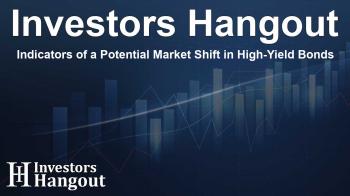Indicators of a Potential Market Shift in High-Yield Bonds

Market Signals Indicating a Possible Shift in Junk Bonds
The current climate of unusually low spreads in junk bonds could spell trouble for investors, as suggested by a prominent economist. These conditions are eerily reminiscent of the state of the market before the 2007 financial crisis, raising alarm bells for market participants.
Understanding Junk Bonds
High-yield, or junk, corporate bonds are classified as those having a credit rating below investment grade. These bonds typically offer higher yields due to their increased risk, making them attractive to certain investors. However, the stability of these credit spreads is crucial in assessing market health.
Key Observations by Economists
Notable macro strategist at Crescat Capital, Otavio Costa, has pointed out that credit spreads of junk bonds have remained consistently below 3% for over 100 days. This situation is reminiscent of similar patterns seen just before the crisis in May 2007.
What Recent Trends Reveal
Costa shares insights on how a prolonged period of narrow credit spreads could lead to a swift spike in volatility. He metaphorically describes these tight spreads as "tinder — just waiting to catch fire," emphasizing the precarious position the market currently finds itself in. Such conditions can lead to rapid shifts in investment sentiment.
The Implications of Tight Spreads
When credit spreads are lower, it typically indicates that investors are more confident about a company’s ability to meet its debt obligations. This confidence can sometimes lead to complacency, causing greater risk-taking behaviors among investors. The prevailing low spreads might be signaling overconfidence in riskier assets.
Why This Matters Now
A deeper understanding of how these junk bonds interact with the market environment is essential. The current market dynamics can influence broader economic conditions, affecting everything from corporate financing to consumer lending. A potential shift could have wide-reaching impacts.
Current Financial Metrics
As of the latest updates, the broader financial landscape shows fluctuations in treasury yields. The 10-year Treasury yield was reported at approximately 4.43%, while the two-year yield registered at 4.20%. These figures give added context to the state of the market and how investors might react in times of uncertainty.
Moving Forward: What Investors Should Consider
Investors should remain vigilant during this time of compression in junk bond spreads. Historical patterns suggest that such trends often precede periods of elevated market volatility. The observations by economists like Costa should encourage a careful evaluation of investment strategies moving forward.
Frequently Asked Questions
What are junk bonds?
Junk bonds, or high-yield bonds, are securities with a credit rating below investment grade, offering higher yields due to increased risk.
Why are low junk bond spreads a concern?
Low spreads could indicate market complacency and excessive risk-taking by investors, posing risks if volatility increases.
How did the 2007 crisis relate to current conditions?
The conditions before the 2007 crisis showed similar patterns to today's junk bond spreads, indicating potential market instability.
What is the significance of Treasury yields?
Treasury yields serve as a benchmark for various interest rates and can influence expectations about market conditions and investor behavior.
How can investors prepare for potential shifts?
Investors should assess their portfolios for risk exposure and consider strategies that could mitigate potential downturns in the market.
About The Author
Contact Addison Perry privately here. Or send an email with ATTN: Addison Perry as the subject to contact@investorshangout.com.
About Investors Hangout
Investors Hangout is a leading online stock forum for financial discussion and learning, offering a wide range of free tools and resources. It draws in traders of all levels, who exchange market knowledge, investigate trading tactics, and keep an eye on industry developments in real time. Featuring financial articles, stock message boards, quotes, charts, company profiles, and live news updates. Through cooperative learning and a wealth of informational resources, it helps users from novices creating their first portfolios to experts honing their techniques. Join Investors Hangout today: https://investorshangout.com/
The content of this article is based on factual, publicly available information and does not represent legal, financial, or investment advice. Investors Hangout does not offer financial advice, and the author is not a licensed financial advisor. Consult a qualified advisor before making any financial or investment decisions based on this article. This article should not be considered advice to purchase, sell, or hold any securities or other investments. If any of the material provided here is inaccurate, please contact us for corrections.

